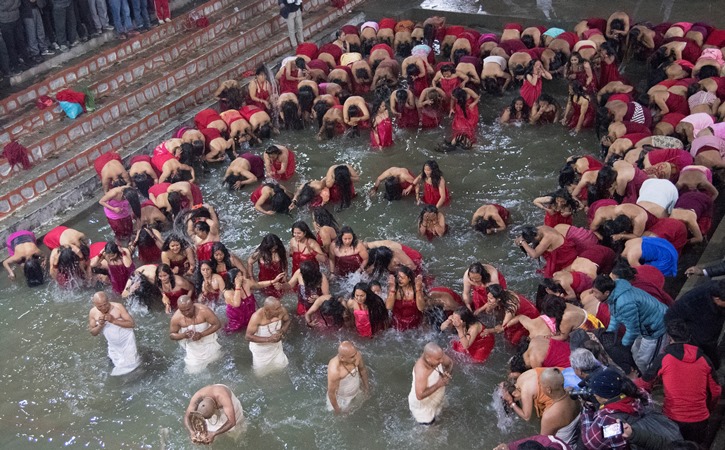Swasthani fast, story recital begins today

By A Staff Reporter
Kathmandu, Jan. 28: A month-long fasting and reading Swasthani Katha, a holy book of Hindus, is beginning from Thursday all over Nepal.
Hundreds of devotees are all set to begin their month-long devotion on the bank of the Salinadi River at Sankhu, in Sankharapur Municipality, in the north east corner of the Kathmandu Valley.
Described in the Swasthani Katha as a sacred, healing and wish fulfilling, the river holds a special place among the faithful during the fasting.
Legend has it that a leprosy victim named Chandrawati regained her health, social status and good fortune after worshipping goddess Swasthani and taking holy dips in the river.
Even to this day, devotees from far and wide visit the river for holy bath during the fasting month. People inhabiting Sankhu, the ancient town located in the outskirts of Kathmandu, observe the fast with rigorous discipline and rituals.
Those who practice the fasting in earnest forget all physical aspects of life and concentrate on its spiritual aspect, especially on the devotional activities.
Earlier, men and women of all ages used to observe this fasting. However, this year, Shree Madhav Narayan Swasthani Fasting and Salinadi Management Committee, the authority overseeing the programme, has imposed an age bar. Only the devotees aged between 20 and 50 years are allowed to fast, and Polymerase Chain Reaction (PRC) test report is mandatory for all fasting devotees, said Mijendra Kaji Shrestha, president of the committee.
Wishing for a prosperous life, perpetual luck and happiness, the fasting is observed.
Swasthani literally means goddess, and the fasting and storytelling are said to be practiced only in Nepal.
Falling in the months of January and February, the entire fasting month is dedicated to goddess Swasthani, and the devotees are required to follow strict rules during that time.
Throughout the month, every fasting devotee eats only a single unsalted meal. What’s more, they take holy dip in the river in the morning and visit different shrines by day, walking walk barefoot. In addition, they refrain themselves from using cosmetic items.
They are required to live on strict diet -- rice, carrot, bean, ginger, ghree, chaku, sugar, beaten rice and milk.
On the day of Ekadashi, they can eat fruits like banana, yam, sugarcane and orange. On the day of Saptami, the male fasting devotees, dressed only with loin cloth, walk through the Sankhu town.
The historical town of Bhaktapur also observes this fasting but rituals there are different from those of Sankhu.
The story of Swasthani mentions king Nabaraj ruling the country called Labanya, which is also the ancient name of Sankhu.
Nabaraj had become the king after his mother observed Swasthani fasting. His consort Chandrawati becomes a leper after insulting goddess Swasthani. Later, when she got repentant and started worshipping the goddess, she regained her health and wellbeing, as per the legend.
At the middle of the Salinadi River, there stands a big rock, which people worship as the symbol of Chandrawati throughout the fasting month.
Recent News

Do not make expressions casting dout on election: EC
14 Apr, 2022
CM Bhatta says may New Year 2079 BS inspire positive thinking
14 Apr, 2022
Three new cases, 44 recoveries in 24 hours
14 Apr, 2022
689 climbers of 84 teams so far acquire permits for climbing various peaks this spring season
14 Apr, 2022
How the rising cost of living crisis is impacting Nepal
14 Apr, 2022
US military confirms an interstellar meteor collided with Earth
14 Apr, 2022
Valneva Covid vaccine approved for use in UK
14 Apr, 2022
Chair Prachanda highlights need of unity among Maoist, Communist forces
14 Apr, 2022
Ranbir Kapoor and Alia Bhatt: Bollywood toasts star couple on wedding
14 Apr, 2022
President Bhandari confers decorations (Photo Feature)
14 Apr, 2022










